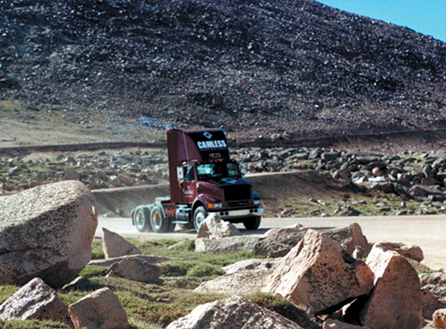
Diesel Goes Digital to Save Energy, Lower Emissions
Originating Technology/ NASA Contribution
Forty years ago, actuators requiring constant energy to help power the Apollo spacecraft in space were replaced by magnetically holding and releasing, electronically controlled valves. Today, these same magnetic, electronic valves are on the verge of replacing entire camshaft systems in cars and trucks on Earth, thus leading to a whole new generation of low-emission engines.
Partnership
NASA requires efficient and lightweight valves for controlling thrusters in spacecraft. While at Bell Aerospace in the 1960s, Eddie Sturman developed a very efficient valve control actuator that consumed little energy. Sturman’s work resulted in five patents and systems that were extensively used throughout the Space Program. According to the Space Foundation, a non-profit organization aimed at advancing the exploration, development, and use of space, Sturman’s valve control actuator likely was one of the energy-saving factors that enabled Apollo 13 to find the additional power it needed to return to Earth.
Product Outcome
Recognized by Popular Science magazine as the “Best of What’s New” for 2000 and inducted into the Space Foundation’s U.S. Space Technology Hall of Fame in 2003, Sturman’s “digital valve” consists of a specially designed spool with a magnetic holding and releasing mechanism on its side and two opposing electromagnetic coils. The magnetic holding and releasing is commanded by sophisticated electronic processors, causing the spool to pass back and forth at tremendous speeds with remarkable precision to ensure accurate control of the pressurized hydraulic fluid that is pumped through the valve’s opening. This allows the digital valve to open and shut extremely fast. Additionally, the valve can remain in the desired open/closed position due to magnetism from the component’s electromagnetic coils. In effect, it saves energy, provides far greater fuel economy, and generates much less pollution than comparative valves.
Sturman had a plethora of non-aerospace uses in mind when he formed his own company, Sturman Industries , in 1989 to commercialize the digital valve initially developed for NASA and subsequently used in space. Original applications for the technology included implementation in battery- and solar-powered irrigation systems, but as Sturman continued to improve upon the design specifications for the valve, the company’s focus shifted to making engines operate more efficiently.
From low-speed diesel to high-speed gasoline, and from heavy-duty trucks to standard passenger cars, Sturman Industries’ Hydraulic Valve Actuation (HVA) system—controlled by the digital valve—provides the flexibility and precision required for clean, practical, and safe “camless” engine technology. Instead of using a traditional valve train consisting of a camshaft, push rod or cam chain, lifters, rocker arms, and valve springs, the camless engine utilizes HVA to open and close engine valves. HVA eliminates the mechanical linkage between the engine valves and the camshaft and allows for fully flexible engine valve operation.
In modern-day engines, the camshaft contains “lobes” (also called cams) that push against the engine valves to open and close them as the camshaft rotates. The size of these lobes determines the timing of the opening and closing of the valves, which allow the flow of fuel and oxygen into the engine’s cylinders. This timing is critical and can have a great impact on an engine’s performance at different speeds. In the Sturman camless system, however, timing is flexible and can be optimized for idle, acceleration, or full power, thus allowing the engine to “breathe easy” and perform well at all speeds. With a healthier respiration process, the camless engine offers cleaner emissions.
In 2000, history was made as a big-rig truck equipped with a Sturman HVA system became the first camless vehicle to make it to the top and back of Pikes Peak in Colorado without shutting down the engine. The accolade took place at the annual Pikes Peak International Hill Climb, the second-oldest motor race in U.S. history. One by one, vehicles race against the clock as they climb more than 12 miles to the top of the 14,110-foot summit, all while steering through 156 hairpin turns. In the same year, Sturman Industries successfully took a camless truck on a 10,000-mile tour across America. Even though camless engines are not yet considered mainstream on the automotive assembly line, the company’s HVA system has been delivered to customers worldwide.
The digital valve has also been folded into fuel injectors, pneumatic valves, fluid transistors, airbags, suspension systems, and integrated electronic systems. Ford Motor Company’s Power Stroke® 6-Liter OHV (overhead valve) V-8 turbo-diesel engine features the Sturman technology in the form of a hydraulic-assist direct fuel injection system. Sturman Industries’ high injection pressures reduced the Power Stroke’s nitrogen oxide emissions by 20 percent, compared to the Power Stroke’s 7.3-liter predecessor, and greatly diminished the “clatter” that is associated with diesel engines. These improvements and others contributed to the Power Stroke being named one of 2003’s “10 Best” engines by Ward’s AutoWorld, a premier automotive magazine.
Non-automotive applications for the technology are numerous, ranging from carpet manufacturing to carbon dioxide-charged dispensers that prevent beverages from going flat.
Power Stroke® is a registered trademark of Ford Motor Company.

A big-rig truck equipped with a Hydraulic Valve Actuation system from Sturman Industries became the first camless vehicle to make it to the top and back of Pikes Peak without shutting down the engine.

A camless truck passes through Times Square on the tail end of its 10,000-mile trek across country to New York City, where Sturman Industries was presented with a “Best of What’s New” award from Popular Science magazine.













